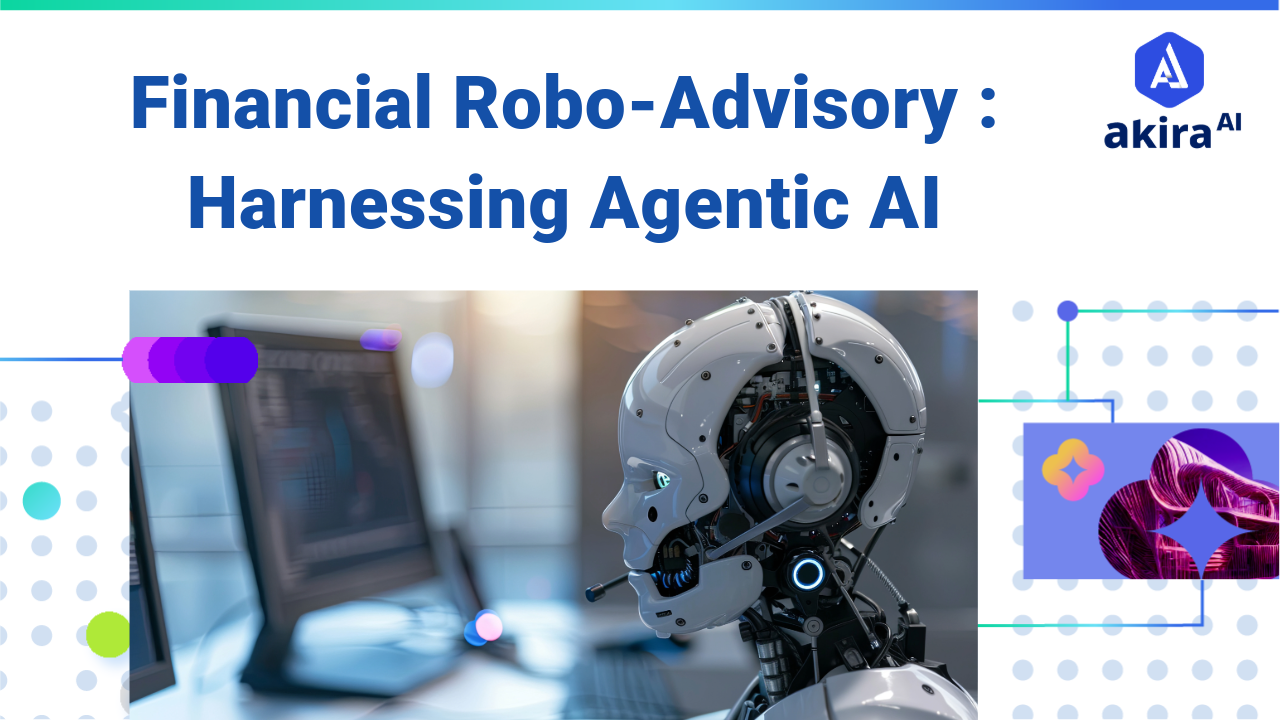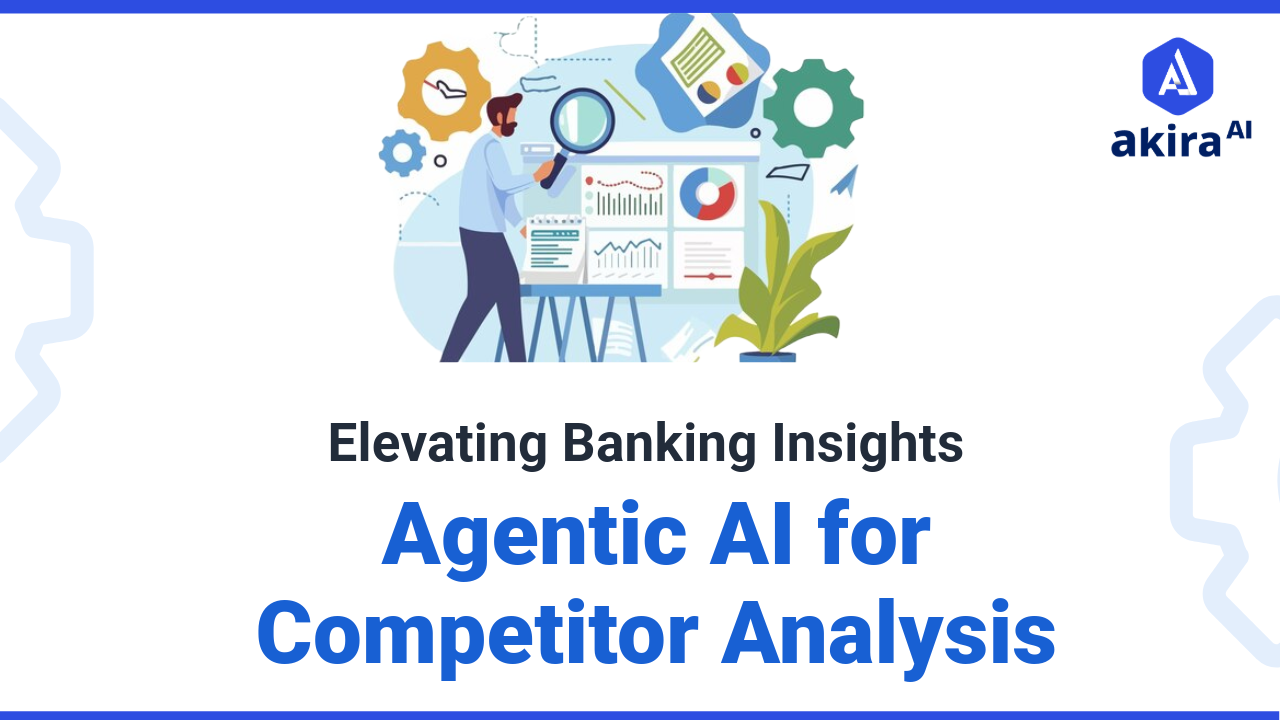Key Insights
Multi-agent systems utilizing AI are revolutionizing automated regulatory reporting in banking by streamlining data collection, ensuring compliance, and reducing operational risks. These systems enhance reporting accuracy, provide real-time insights, and adapt to evolving regulatory landscapes, fostering stronger relationships with stakeholders.
In an era of ever-increasing regulatory scrutiny, banks are harnessing the power of technology to enhance compliance. Multi-agent systems, underpinned by agentic AI and agentic workflows, offer transformative solutions for automated regulatory reporting. These intelligent systems streamline reporting processes, mitigate risks, and ensure accuracy, enabling banks to not only comply with regulations but also build trust with stakeholders. This blog delves into the intricacies of multi-agent systems in regulatory reporting, exploring their operational benefits, use cases, and future potential.
Multi-Agent for Automated Reporting in Banking Regulatory?
MAS comprises a multitude of independent agents which work and interact to accomplish complex tasks. In banking, these agents can automatically capture data, do calculations, and prompt the generation of reports from a variety of demands. In this sense, such a system will permit agentic AI to streamline decision-making, reduce human intrusion, and supply sound timely probes.
It is a must-have tool through which banks ensure local and global compliance with the regulation, including Basel III, Dodd-Frank, and MiFID II. Moreover, the very stringent nature of regulatory requirements necessitates that banks adopt reporting systems that are efficient, accurate, and transparent. The multi-agent system, as developed with AI, therefore allows for automatic data collection, validation, and submission processes to be properly compliant at minimal operational risk.
Overview of Multi-Agent Systems for Automated Banking Regulatory Reporting
It is defined as an entity carrying out specific tasks in a given environment using artificial intelligence techniques. It can perceive the environment, process information, make decisions, and act according to its appropriateness in achieving the given objectives. Its characteristics are autonomy, adaptability, interactivity, goal-oriented behavior, and intelligence. This refers to learning based on experience and operation either autonomously or collaboratively.
AI agents will streamline and improve the accuracy of automated regulatory reports from banks. They collect data from every possible source, process to ensure accuracy, in compliance with the regulatory requirements, and present the reports in the desired format. Through report submission, AI agents reduce errors and missed deadlines. The system tracks regulation changes and revises the reporting procedures with changes that come with the evolution of regulations so that it keeps pace with the strategic plans of bankers.
Comparison Between Traditional vs. Agentic AI Automated Report Regulatory
|
Aspect |
Traditional Methods |
Agentic AI-Based Multi-Agent Systems |
|
Data Entry |
Manual data entry leads to potential errors and inconsistencies. |
Automated data collection minimizes errors and ensures consistency. |
|
Validation |
Time-consuming manual checks for data accuracy and compliance can delay reporting processes. |
AI-driven validation processes enhance accuracy and speed up reporting. |
|
Operational Risk |
High risk of human error in manual reporting, which can lead to compliance issues and regulatory penalties. |
Reduced human involvement lowers the risk of errors, enhancing compliance reliability. |
|
Scalability |
Difficult to scale with changes in regulatory requirements or data volumes, requiring substantial manual input. |
Easily adaptable to changing regulations and increasing data volumes with minimal input. |
|
Monitoring |
Lacks real-time monitoring capabilities, leading to reactive compliance management. |
Continuous monitoring enables proactive compliance management and timely adjustments. |
|
Cost Efficiency |
High operational costs due to extensive manual labor involved in the reporting process. |
Lower operational costs by reducing reliance on manual labor for reporting tasks. |
Akira AI multi-agent in action
-
Data Ingestion from Multiple Sources: The process begins with the ingestion of data from multiple internal and external sources. These sources include core banking systems that hold transactional and operational data, financial data warehouses that store historical financial information, and external regulatory data feeds that provide up-to-date regulatory guidelines and requirements. This ensures that the system gathers comprehensive, real-time data necessary for accurate regulatory reporting.
-
Centralized Orchestration: A centralized orchestration system manages the overall workflow of the reporting process. It ensures that data flows seamlessly between various stages, such as ingestion, validation, and reporting while coordinating tasks between different subsystems. This orchestration guarantees that tasks are completed in a logical order, minimizing processing time and optimizing the data flow for faster, more efficient reporting.
-
Data Quality Assurance and Validation: After data ingestion, the system performs quality checks to ensure the data is complete, accurate, and aligned with regulatory requirements. The validation process identifies any discrepancies, inconsistencies, or missing data, which are then flagged for resolution. By automating this validation step, the system ensures that the reporting is reliable and reduces the risks associated with human error, such as incorrect entries or oversight.
-
Automated Report Generation and Compliance Auditing: Once the data has been validated, the system generates regulatory reports in the required formats specified by regulatory authorities. The system follows predefined reporting guidelines and automatically formats the reports to ensure they meet compliance standards. Simultaneously, an audit trail is maintained throughout the entire process, recording every action, adjustment, or update made. This audit trail is critical for demonstrating compliance during inspections or audits, as it provides a transparent record of how the data was processed and reported.
-
Dashboard Insights and Report Submission: After the reports are generated, the system provides insights through compliance dashboards and risk metrics. These dashboards allow internal teams to review the outcomes, assess risk exposure, and make necessary adjustments before final submission. Once approved, the system submits the reports to the appropriate regulatory bodies, ensuring deadlines are met and the reports align with current compliance standards. This end-to-end automation from data ingestion to submission significantly reduces operational costs, improves accuracy, and ensures continuous adherence to evolving regulatory requirements
Use Cases of AI Agents in Automated Regulatory Reporting for Banking
-
Data Aggregation: Multi-agent systems will automatically collect data from various internal and external sources, which include core banking systems, financial data warehouses, as well as external regulatory data feeds. They'll ensure that all required data to derive those reports is combined, accurate, and captured in real-time with minimal intervention by humans to minimize the chances of errors and ensure the quality of that report.
-
Compliance Auditing: Such systems continually check cross-matches with the regulatory requirements and flag discrepancies or violations of such requirements in real time so that problems are flagged to the attention of the bank before the submission of the actual report. This makes the banks complain and prevents penalties arising from missing data or wrong submission of data.
-
Real-Time Report: Such multi-agent systems provide real-time regulatory reports through continuous processing and updating from different sources. Such capability to provide an up-to-date report instantly allows banks to respond very quickly to any regulatory query, conduct internal audits, and meet strict reporting deadlines without risks of delayed submissions.
-
Regulating Change Management: These systems follow the changes in regulatory policies and adjust reporting processes accordingly. In addition to that, new rules lower the chances of getting into non-compliance since reporting formats are automatically updated, and compliance is checked. In such ways, multi-agent systems keep reporting updated about the latest legal requirements without updates being manual.
-
Risk Management: It constantly monitors the data and reports the processes by taking the chance that may come from non-compliance. One can use it to discover areas where mistakes or delays might trigger fines or penalties against the bank and thus give it ample opportunity to take steps before the matter sets in. This predisposes the bank to financial and reputational damage.
-
Cost-effective: It can minimize operational costs for multi-agent systems associated with such reporting to the regulator because they can automate the redundant and time-consuming activities such as data gathering, validation, report generation, and submission. Human error possibilities also decline since less manual effort is utilized; it may be pricey enough but also carries some financial penalty costs.
-
Custom reporting: Multi-agent systems help banks tailor particular regulatory reports to fit the needs of multiple regulatory bodies functioning in different regions. Tailoring would ensure compliance within a report as it would follow the prevalent regulations in that region and make global banking operations' reporting efficient and smooth. Not only this, but banks can also manage reports for different jurisdictions effectively.
Functionality of AI Agents in Automated Regulatory Reporting for Banking
-
Data Ingestion Agent: The Data Ingestion Agent automates the collection and integration of data from various sources, ensuring accurate accessibility for reporting. It reduces manual entry, minimizes errors, and enhances reporting efficiency.
-
Report Generation Agent: The Report Generation Agent compiles and formats data into regulatory reports, adhering to required standards and deadlines. It automates report creation, reducing compliance teams' workload and enabling quick template modifications.
-
Data Quality and Validation Agent: The Data Quality and Validation Agent ensures the integrity and reliability of reporting data by validating accuracy, completeness, and consistency. It identifies errors and discrepancies, minimizing compliance risks due to faulty reporting.
-
Audit Trail and Compliance Agent: The Audit Trail and Compliance Agent maintains transparency by logging all activities in the reporting process, providing a comprehensive audit trail. It facilitates compliance with regulations and offers necessary documentation for audits.
-
Analytics and Insights Agent: The Analytics and Insights Agent analyzes processed data to derive actionable insights regarding regulatory performance and compliance. It informs strategic decisions and identifies areas for improvement in reporting practices.
-
Master Orchestrator Agent: The Master Orchestrator Agent acts as the central control unit, coordinating interactions between various agents and managing task assignments. It monitors progress, addresses issues, and enhances efficiency in regulatory reporting.
Operational Benefits of Automated Report Regulatory
-
Streamlined Workflow Integration: Seamless integration into existing workflows enhances regulatory reporting processes without requiring significant system overhauls. Automation of routine tasks reduces bottlenecks, enabling teams to concentrate on strategic activities and improving overall productivity.
-
Enhanced Risk Management: Advanced analytics and real-time monitoring identify compliance risks early, bolstering risk management efforts. This proactive approach mitigates the likelihood of regulatory breaches, fostering a robust compliance culture within the organization.
-
Increased Agility in Reporting: Organizations can quickly adapt to changes in regulations and fluctuations in data volume with AI-driven multi-agent systems. This agility maintains compliance efficiently, preventing excessive costs or delays and ensuring operational continuity.
-
Improved Audit Readiness: Comprehensive audit trails are automatically maintained, logging all actions and data modifications. This capability enhances audit readiness, simplifying compliance reviews and demonstrating transparency and accountability during audits.
-
Enhanced Data Insights and Reporting Quality: Utilization of machine learning algorithms improves the quality of reports through better data analysis. This results in insightful reports that not only satisfy regulatory requirements but also inform strategic decision-making.
-
Comprehensive Compliance Framework: Establishing a robust compliance framework allows for ongoing assessments to ensure alignment with regulatory standards. This proactive stance positions organizations for long-term success in compliance management.
-
Strengthened Stakeholder Relationships: Accurate and timely reporting fosters stronger relationships with regulators and stakeholders, showcasing the organization’s commitment to compliance. This transparency enhances trust and confidence, which are essential for maintaining a positive reputation in the industry.
-
Innovation-Driven Culture: Encouragement of a culture of innovation empowers employees to explore new compliance processes. This drives continuous improvement positions organizations as industry leaders and promotes collaboration across departments.
Technologies for AI-Driven Automated Regulatory Reporting in Banking
Several key technologies are driving the transformation of multi-agent systems in regulatory reporting, enhancing efficiency, accuracy, and compliance:
-
Machine Learning Algorithms: These algorithms allow AI agents to analyze vast amounts of data and learn from historical patterns. By identifying trends and anomalies, these agents can make informed decisions, ultimately improving the accuracy of regulatory reports and enabling proactive compliance measures.
-
Natural Language Processing (NLP): NLP technologies enable agents to interpret and understand complex regulatory texts. This capability streamlines the compliance process, as agents can automatically extract relevant information and apply it to reporting requirements, reducing manual interpretation errors.
-
Blockchain Technology: Implementing blockchain enhances the security and transparency of the reporting process. By creating a decentralized ledger for transactions and data modifications, blockchain ensures data integrity and provides an immutable audit trail, which is essential for compliance and accountability
-
Cloud Computing: Cloud technology offers the necessary scalability and flexibility for multi-agent systems to function efficiently. By utilizing cloud solutions, banks can quickly adjust to fluctuating data volumes and regulatory demands, facilitating seamless integration and real-time collaboration among agents.
-
Robotic Process Automation (RPA): RPA automates repetitive and time-consuming tasks within the reporting workflow, such as data entry and validation. By minimizing manual intervention, RPA enhances operational efficiency, allowing compliance teams to focus on more strategic activities, thereby reducing the risk of human error.
The Future of AI Agents for Multi-Agent for Automated Regulatory Reporting in Banking
The future of AI agents within multi-agent systems for automated regulatory reporting is poised for significant advancements, promising greater efficiency and compliance capabilities:
- Increased Adoption: As regulatory environments become more complex and dynamic, banks are likely to adopt AI-driven solutions more broadly. This trend reflects a growing recognition of the need for robust compliance tools that can adapt to evolving regulations.
- Enhanced Interoperability: Future multi-agent systems will be designed to integrate seamlessly with existing banking infrastructures. This interoperability will enable more efficient data sharing and reporting across various platforms, improving overall compliance workflows.
- Advanced Analytics Capabilities: AI agents will harness sophisticated analytics tools to gain deeper insights into compliance risks and reporting efficiencies. These capabilities will empower banks to anticipate potential regulatory challenges and refine their reporting processes.
- Greater Customization Options: Banks will benefit from the ability to customize their reporting solutions to meet specific regulatory requirements. This flexibility will ensure that organizations can address localized regulations effectively while maintaining compliance with broader standards.
- Continuous Learning Mechanisms: Future AI agents will incorporate reinforcement learning techniques, allowing them to learn and adapt based on historical data and compliance outcomes. This continuous learning process will enhance agent performance over time, leading to improved reporting accuracy and responsiveness to regulatory changes.
Conclusion:Regulatory Reporting in Banking
The implementation of multi-agent systems for automated regulatory reporting represents a significant advancement for the banking sector. By harnessing the power of agentic AI and agentic workflows, banks can streamline compliance processes, enhance accuracy, and foster trust with stakeholders. As regulatory requirements continue to evolve, the integration of AI agents will be critical in ensuring that banks remain compliant and efficient in their reporting efforts. The future is bright for multi-agent systems, offering innovative solutions that can transform regulatory reporting in banking and beyond.
Sales AI: Boost Productivity with Trusted AI Built Directly into Your CRM.







